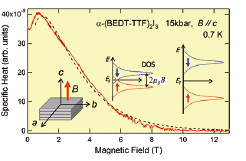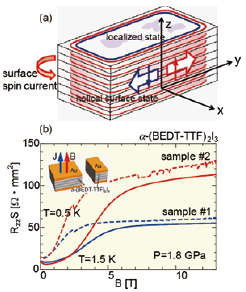Experimental Confirmations of Dirac Fermions and Helical Suface State in an Organic Zerogap Conductor
Osada Group
It has been theoretically predicted that the quasi-2D massless Dirac fermion system is realized in a layered organic conductor α-(BEDT-TTF)2I3 under high pressures. By transport and thermodynamic measurements, we have obtained the experimental proofs of realization of Dirac fermions and a novel surface state at the high-field quantum limit.

Fig. 1. Field dependence of specific heat at 15kbar. The decrease of the specific heat means the decrease of DOS at the Fermi level. It is an evidence of spin splitting of the n=0 LL.

Fig. 2. (a) Helical surface state in the ν=0 QH state in a Dirac multilayer. (b) Interlayer magnetoresistance scaled by cross sectional area of two samples prepared by cutting one crystal. Their mismatch in the saturation region is an evidence of non-uniform conduction.
(1) Density of states of Dirac fermions
The temperature dependence of the specific heat shows almost quadratic behavior at low temperature, suggesting linear energy dispersion in this system. In a magnetic field, the specific heat increases as the field increases, and then turns to decrease in high field (Fig. 1). This behavior can be understood by assuming the n=0 Landau level (LL), so-called zero-mode, characteristic of the Dirac fermion system; In perpendicular magnetic field above 0.2 T, the α-(BEDT-TTF)2I3 is in the quantum limit, where only the zero-mode exists at Fermi energy EF. The density of states (DOS) of the zero-mode increases in proportion to the magnetic field, reflecting the LL degeneracy. In addition, each LL splits as 2μBB in the magnetic field because of the Zeeman effect (spin splitting). As a result, the DOS at EF first increases with magnetic field, and then starts to decrease in a high magnetic field when the spin splitting becomes larger than the LL broadening. These results are quite consistent with the reported magnetoresistance. When we take into account the field dependence of the LL broadening width Γ∝B1/2 predicted in the self-consistent Born approximation, we can fit our data satisfactorily by using the Gaussian shaped LL (broken line in Fig. 1).
(2) Surface transport due to helical surface state
The ν=0 quantum Hall (QH) state can be expected in the field range where the spin splitting of the n=0 LL becomes sufficiently large. In this situation, a pair of QH edge channels with opposite spin and chirality must be formed along the edge on each layer. The interlayer tunneling couples these edge states on different layers, resulting in the formation of the "helical surface state" surrounding the edge surface (Fig. 2(a)). The helical surface state contributes to metallic surface transport, which becomes dominant contribution to interlayer transport at high fields and low temperatures where activated bulk transport becomes exponentially small. We have proposed this scenario to explain the observed saturation of the interlayer magnetoresistance.
To confirm the existence of the helical surface state, we have experimentally studied the saturation feature as a function of the cross sectional area and the perimeter of samples. As shown in Fig. 2(b), the interlayer magnetoresistance is well scalled by the sectional area, indicating the bulk uniform conduction, in low field region. However, the high-field saturation is never scaled by the cross sectional area, indicating the non-uniform transport such as surface transport. The strong correlation between the saturated value and the sample perimeter strongly suggests the surface transport due to the helical surface state.
